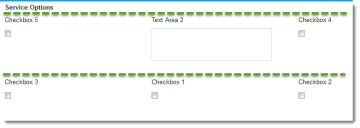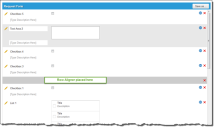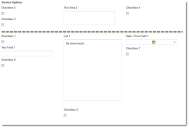Service Manager powered by HEAT
Working with Form Offerings
•Modifying a Request Offering Form
Creating a Form Offering
Service owners have the ability to create new or modify templates from any business object configured for My Items, and not depend on the administrator to provide new templates.
The request offering template enables service owners to create incident, change, request, and approval templates for requesters in the Self-Service Portal. Like other request offerings, these templates can be made available to all organizational units that exist on the tenant or only to specific organizational units. By default, the new offering templates are published to the entire organization.
Any business object that is part of the MyItem configuration (by default, incident, service request, and approval) can be made available through a form offering. You can add relationships to other business objects (for example, change) to MyItem, then use the corresponding templates.
1.Log in to the application as a service owner.
2.Open the Request Offering workspace.
3.Click New > Form Offering from the toolbar. The Define Form Offering page appears.
4.Enter information into the fields.
| Field | Description |
|---|---|
| Service | The service for which the form applies. Select from the drop-down list. This list is populated from the Services workspace. |
| Name | A unique name for the service. |
| Description | Optional. Describes how the form is used. |
| Anonymous Submit | Allows anonymous users to submit a request. |
| Categories | Click Add a Category to select a category for this form. Repeat to add more categories. |
5.Click Next. The Select Form Layout page appears.
6.Enter information into the fields.
| Field | Description |
|---|---|
| Change Image |
A default image for the service appears. To change the image, click Change Image and navigate to an image, then click Open. The image size cannot be larger than 50 KB. We recommend square images. The image size can be as large as you like, but it is scaled down to 48 by 48 pixels. See Default Icons for Request Offerings, Form Offerings, and External Offerings. |
| Business Object | A business object. Select from the drop-down list. |
| Object layout | The object layout. Select from the drop-down list. The available layouts are related to the chosen business object. Additional fields appear on the page. |
| Apply template | Optional. A template that automatically populates certain fields. Select from the drop-down list. |
7.Enter information into the remaining fields. These fields vary according to the chosen business object and object layout.
8. Click Next. The Publish Action page appears.
9.Enter a status:
•In Design: Saves the form offering without publishing it to users. You can modify this form offering later.
•Published: Saves the form offering and makes it available under request offerings, but not under the Service Catalog. When setting this status, by default the organizational unit of the owner is added with all permissions checked. This form offering is available in the Service Catalog for this organizational unit unless modified.
10.Click the add icon  to add an organizational unit. A new unit is added with the default name of Any.
to add an organizational unit. A new unit is added with the default name of Any.
11.Optional Click Any to select the action to perform when saving this form offering:
| Action | Description |
|---|---|
| Org Unit | Selects an organizational unit from the list. You can only publish request offerings to organizational units to which you have access. For example, if you do not have access to the entire organization, your published offering will only be available to users in the organizational unit that you have selected and below. You can only publish to an organizational unit to which you belong, and its parent and child units. |
| Location | Only publishes to specific locations. You can designate multiple locations. |
|
Permissions |
|
| Submit | Allows this request to be submitted from the Service Catalog by the designated organizational unit. |
| Edit | Enables users within the organizational unit to modify the request offering (not the resulting service request). The request offering owner/creator has edit permissions by default. |
| Delete | Enables users within the organizational unit to delete the request offering (not the resulting service request). |
| Copy | Enables users within the organizational unit to duplicate the request offering (not the resulting service request). |
12.Optional. Click Delete to remove the organizational unit from the list.
13.To finish, do one of the following:
•Click Save to save the file and publish.
•Click Save and Exit to save the file without publishing. You can make changes to the request offering or delay its publication.
•Click Cancel to dismiss the page and delete all your selections.
Modifying a Request Offering Form
There are several things you can do to get your request offering form looking its best.
Aligning Rows in Columns
This feature aligns the tops of the fields across the columns by rows. Do not use this option with the row aligner.
While in a Design Request Form page, click Layout Configuration, then check Align Rows in Columns.
The Fields in Each Row are Aligned Top
With the Option Not Checked, Rows are Not Aligned
About the Row Aligner
This feature aligns the tops of the fields by section. Only the first row of fields placed on the form after the row aligner are aligned top.
While in a Design Request Form page, drag Row Aligner from the Form Designer Tools pane onto the page where you want the fields to align.
The results of this formatting do not appear correctly in preview mode. You must:
1. Save and publish the request offering.
2.Open the Request Offering in the Service Catalog workspace.
The Row Aligner is Applied Before Checkbox 1
The Form Using the Row Aligner
Was this article useful?
The topic was:
Inaccurate
Incomplete
Not what I expected
Other
Copyright © 2017, Ivanti. All rights reserved.



